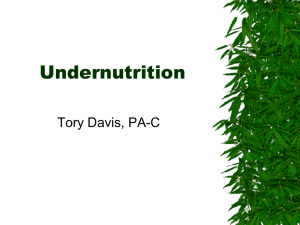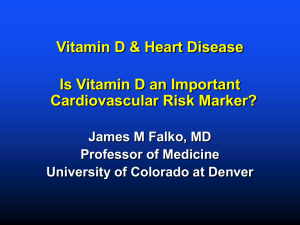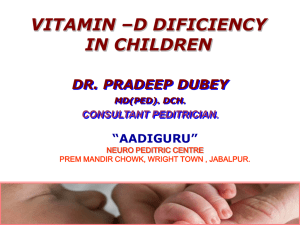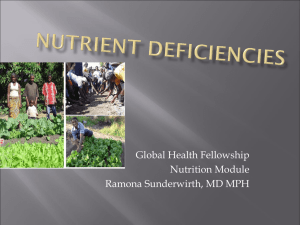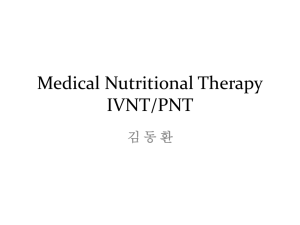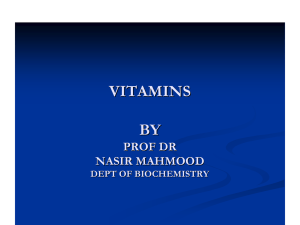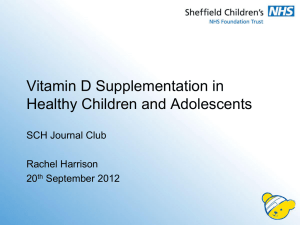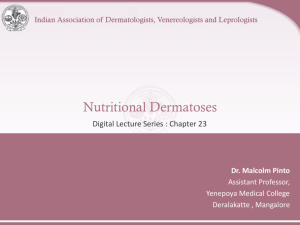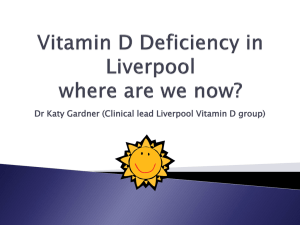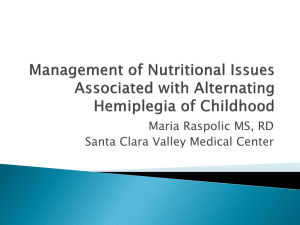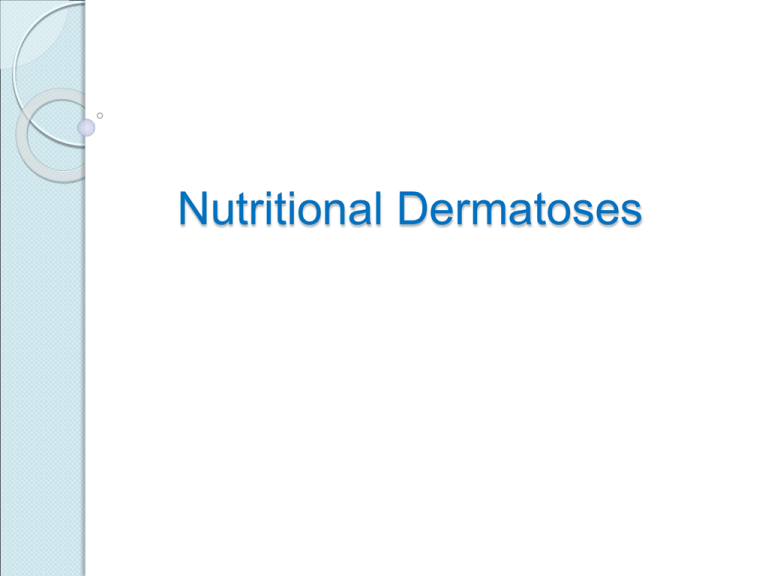
Nutritional Dermatoses
Stages of nutritional deficiency syndrome
Stage I
Intake falls below daily requirement but the
reserves maintain normal blood values
Stage II
Blood levels decrease but patient is
asymptomatic
Stage III
Development of clinical signs and symptoms
Causes of deficiencies
Decreased intake
Increased requirement
Poverty
During growth
Ignorance
Pregnancy
Food faddism
Lactation
Crash diets
Fever
Anorexia nervosa
Hyperthyroidism
Stages of nutritional deficiency syndrome
Decreased absorption and utilization
GI - mucosal disturbances: Malabsorption
syndrome
Dietary factors: High dietary phytate, TPN,
alcoholism
Trauma: Burns , Post surgical procedures
Malignancy
Renal disorders
Infections: Parasitic, bacterial, viral
Miscellaneous: Collagen vascular disease, HIV
Nutritional deficiencies
Fat soluble vitamins (A,D,E,K)
Water soluble vitamins
(B-complex, Niacin, Pantothenic acid, Biotin, Vit C)
Minerals
Trace elements (Zinc, Iron)
Essential fatty acids (EFA)
PEM (Protein energy malnutrition)
Important Points
1. Water soluble vitamins
◦ Not stored in body
◦ Excessive consumption
No toxicity
2. Fat soluble vitamins (A, D, E, K)
◦ Stored in liver
◦ Excessive consumption
toxicity
Vitamin A (Retinol) deficiency
Rich source
Animal fats, fish liver oils, milk, butter, eggs, liver ,
kidneys
Provitamin A (Beta carotene)
Green and yellow parts of plants (spinach, drum
sticks, spring onions, cabbage, pumpkin, carrots,
tomato)
Fruits – mango, papaya
Clinical features
Skin manifestations:
Infants, very young children
Extensive xerosis - an earliest manifestation
Adults: Follicular hyperkeratosis
Sites: extensor of extremities; spreads to
shoulder, face, chest, abdomen, back , buttocks.
Dry, firm brown follicular papule with keratotic
plug covered with loosely adherent scale
On removal of plug, a pit is seen
Clinical features
Skin manifestations:
Phrynoderma (Toad skin)
Mild follicular hyperkeratosis, limited distribution
Mixed deficiencies of Vit.A, Vit.E, B - complex,
Vit.C and EFA
Clinical features
Eye Manifestations:
Common cause of blindness in developing
countries
Earliest symptoms:
◦ Nyctalopia (night blindness)
◦ Hemeralopia (inability to see bright light)
Xerophthalmia:
◦ Conjunctival xerosis
◦ Bitot’s spot
◦ Corneal xerosis
◦ Corneal ulceration
◦ Keratomalacia
◦ Phthisis bulbi, scarring, blindness
Treatment
Normal requirements:
Infants, children < 4 yrs - 1500 IU of Vit. A
> 4 yrs - 5000 IU of Vit. A
Prophylactic Treatment:
Vit. A (2 lacs IU) every 6 months to pre-school
children (Orally retinyl palmitate in oil)
Good quality protein diet + vitamins
Education of local community
Contd…
Treatment
Dose of 1-3 lacs IU of Vit. A for 1-3 days
(Stop in case of headaches)
Supplements: Vit. B complex and EFAs
Diet to include eggs, milk, butter, green leafy
vegetables
Treatment of underlying cause
(especially protein and zinc deficiency)
Vitamin D
Vit. D is a group of antirachitic sterol derivatives,
considered as a hormone
Skin: Role in synthesis, storage and release of
Vit. D
Source of Vit. D and Chemistry
Plants
ergosterol
ergocalciferol (Vit D2)
Animal and dairy products (Eggs, liver, butter,
codliver oil)
7 dehydrocholesterol (human skin)
UVB
Cholecalciferol (Vit. D3)
Liver
25 hydroxy cholecalciferol
Kidney
1, 25 di-hydroxy cholecalciferol (Calcitriol)
Clinical features and treatment
Children:
Rickets, Tetany
Adults:
Osteomalacia
Type I Vit.D dependent rickets : No skin lesions
Type II Vit.D resistant rickets : Progressive
alopecia
Treatment:
Normal daily requirement: 400 IU
In rickets : 5000 IU oral Vit D for 3 to 5 weeks
Exposure to sunlight
Vitamin B Complex
Mostly combined deficiencies occur due to
insufficient proteins or other essential nutrients
(Zinc, EFA)
Vitamin B1 (Thiamine, Aneurin)
Sources
Yeast (richest source), unmilled cereals, pulses,
nuts
Beriberi Dry
Peripheral neurologic syndrome, atrophic skin,
red burning tongue
Korsakoff's psychosis,Wernicke's encephalopathy
Beriberi Wet
High output cardiac failure
Skin is warm before CCF and cold, edematous,
cracked later
Diagnosis and treatment
Diagnosis
Urinary excretion of < 50 mcg of thiamine after
1 mg injection
Treatment:
Dietary requirement - 0.5 mg /1000 kcal, 0.5 to
2 mg
Beriberi - 10 to 100 mg / day
If severe - add manganese (corrects thiamine
resistance)
B - complex vitamins are supplemented
Local application of zinc oxide ointment ,
mineral oil (for cracked skin)
Riboflavin deficiency (Vit. B2):
(Oro - Oculo - Genital syndrome)
Sources of Vit. B2:
Milk, milk products, eggs, liver, cereals, pulses,
green leafy vegetables
Deficiency of Vit.B2 affects metabolism of free
fatty acids, tryptophan, folic acid
Presents as overlapping manifestations
Clinical features
Seen after 3-5 months of inadequate diet
It is also known as “pellagra sine pellagra”
Oral manifestations:
Angular stomatitis (perleche) with candidiasis
Cheilosis : lip involvement with vertical fissuring
Glossitis : magenta coloured tongue
atrophic filiform papillae
enlarged fungiform papillae
Clinical features
Skin manifestations:
Seborrheic dermatitis like rash; dyssebacea
Fine greasy scales with erythema over nasolabial
folds, ala nasi, nasal bridge, forehead, eyelids,
earlobes
Dysriboflavinosis
Dyskeratotic follicular papules with scaly
erythema
Patchy alopecia with scaling on scalp and
eyebrows
Clinical features
Genitals: Earliest manifestation (scrotum, vulva)
Early - Patchy redness, fine powdery
desquamation
Late - Lichenification
Severe - Raw areas over shaft of penis, inner
thighs
Eyes: Photophobia, lacrimation, blepharospasm,
conjunctivitis, decrease in visual acuity, corneal
vascularization
CNS: Psychomotor, intellectual development
impaired in children
Diagnosis and treatment
Diagnosis
Urinary excretion < 30 mcg of vit.B2 / gm of
creatinine
Treatment:
Normal requirement : 1-2 mg / day mg
Therapeutic dose:
Infants : 1-3 mg
Adults : 10-30 mg
Correct the associated tryptophan, FA, EFA
deficiency
Vitamin B3
(Nicotinic acid, Nicotinamide, Niacin )
Pellagra (deficiency of Niacin)
Italian word pelle - skin, agra - rough
First described in 1735 by Casal in Spain
Niacin includes both nicotinic acid and
niacinamide
Niacinamide is active form and is converted to
coenzymes NAD, NADP
Plays a vital role in cell, fatty acid, carbohydrate
metabolism
Sources
Meat, fish, eggs
Milk, cheese
Cereals, grains, legumes
Coffee and tea
Endogenous production
60 mg of tryptophan
1mg of niacin
Etiology
Staple diet of maize and jowar with less animal
proteins
Maize - poor source of nicotinic acid and
tryptophan
- niacin is present but not bio-available
Jowar - high content of leucine
Imbalance in leucine and isoleucine
of NAD
Tryptophan
Niacin
Chronic alcoholics - unbalanced diet
Malabsorption
inhibition
Clinical features
This disease is characterized by 4 “D’s”
◦ Dermatitis
◦ Dementia
◦ Diarrhea
◦ Death
Prodrome - weakness, fatigue
Clinical features
Skin:
Photo exposed areas
Erythema - well demarcated patches with
pruritus and burning, slight edema
Blisters, dry brown scales
Pressure sites, shoulder, elbow, buttocks, knee
Intertriginous area - redness, maceration
Clinical features
Pellagrins nose
Dull erythema, butterfly rash with scaling on
bridge of nose
Casal's necklace
Sharply demarcated lesion on upper central
chest, neck
Cravat
Anterior continuation of necklace on chest
Scrotal erythema
Symmetrical lesions, clear line of demarcation
Clinical features
Mucous membrane
◦ Angular stomatitis, cheilitis
◦ Scarlet glossitis with imprint of teeth
◦ Tongue is red, smooth, atrophy of filiform
papillae, erosions, ulcerations, fissures
◦ Swelling of parotid gland, increased salivation
GIT: Anorexia, nausea, vomiting, abdominal pain,
bloody diarrhoea
CNS: Depression, psychosis
Treatment
Daily requirement - 10 to 20 mg / day
Therapeutic dose:
300 - 500 mg niacinamide orally or intramuscular
in divided doses (amide preferred because it
does not precipitate flushing, itching, burning)
Supplement with B complex, animal proteins
eggs, milk
Balanced diet
Reduce alcohol
Vitamin B6 deficiency (Pyridoxine)
Animal sources:
Liver, egg yolk, meat
Vegetable sources:
Pulses, cereals, peas, soya beans
Pyridoxine deficiency occurs during
administration of drugs like:
INH
Hydralazine
Cycloserine
Penicillamine
Clinical features
Children: convulsion, anemia
Adults: seborrheic dermatitis like rash, cheilitis,
angular stomatitis, glossitis, peripheral neuritis
Chinese restaurant syndrome :
(Inability to metabolize monosodium glutamate)
Headache, sensation of pressure in chest,
palpitation, feeling of warmth, tingling, numbness
Diagnosis and treatment
Diagnosis
Serum Pyridoxal phosphate levels < 20 mcg / ml
Treatment:
Daily requirement: 1.5 - 2.5 mg
Therapeutic dose: 30 -100 mg / day orally
Vit B12 deficiency
(Cobalamin, Cyanocobalamin)
Sources:
◦ Liver, kidney, heart - richest
◦ Meat, fish, cheese, eggs, milk
◦ Vegetables, fruits, legumes - nil; but present if
contaminated by bacteria
Vit B12 is synthesized in colon (low bioavailability)
Cause of deficiency of Vit.B12
Strict vegetarian diet
Gastric atrophy (achlorhydria) and decreased
intrinsic factor (pernicious anemia)
Diphyllobothrium latum infestation
Malabsorption syndromes (sprue, intestinal TB,
Whipple’s disease)
Elderly individuals, chronic alcoholism
Clinical features
Skin
Symmetrical generalized hyperpigmentation
(greyish - brown)
Mucous membrane
Hyperpigmentation, cheilitis, glossitis with beefy
red tongue, glossodynia, aphthae like lesions
Nails: Pigmented streaks
Hair: Premature graying, canities
Other manifestations: Megaloblastic, pernicious
anemia, peripheral neuritis, poor memory
Diagnosis
Serum Vit. B12 <150 pg/ml
Hemogram
Bone marrow examination
Schilling’s test - measures radioactive Vit. B12
with and without intrinsic factor
Treatment
Daily requirement :1 mcg
Dose : 1000 mcg / week for 1 month;
1000 mcg / month thereafter
Also add folic acid 1- 5 mg
Course:
Cutaneous changes improve within 1 year
In pernicious anemia Vitamin B12 given life long
Folic acid (Vit. B9)
(Pteroyl - glutamic acid, folacin)
Sources:
Liver, meat, green leafy vegetables, milk
Produced by colonic bacteria (inadequate)
Folic acid and Vit. B12 are interdependent,
therefore the deficiencies occur simultaneously
Vit C
Folic Acid
Folinic acid (active form)
Clinical features
Skin:
Diffuse hyperpigmentation
Mucous membrane:
Glossitis, superficial erosions, cheilitis
Others:
Megaloblastic anemia
Diagnosis and treatment
Diagnosis
Serum folate < 3 ng/ml (normal > 6 ng/ml)
Treatment
Daily requirement : 50 -100 mcg
In pregnancy : 400 mcg
Therapeutic dose: 1- 5 mg / day; also correct Vit.
B12 deficiency
Vitamin C (Ascorbic acid)
Scurvy: Deficiency of Vitamin C
Sources:
Fresh fruits - oranges, grapes, lemons
Fresh vegetables - Green leafy vegetables,
potatoes, cabbage
Functions:
Role in collagen and ground substance formation,
wound healing, immune response
Required for iron absorption
Causes
Diet poor in Vitamin C (elderly men, alcoholics)
Gastro-intestinal diseases
Malnourished children with scurvy (Barlow's
disease)
Seen in cigarette smokers
Clinical features
Skin
Follicular hyperkeratosis : Earliest change, cork
screw hair (swan neck deformity) - due to
reduced disulfide bond
Perifollicular hemorrhage
Sites: upper arms, buttocks, shins, trunk, thighs
Petechiae, echhymosis
“Woody” edema of legs
Delayed wound healing
Clinical features
Oral Cavity:
Hemorrhagic gingivitis - spongy gum
Loosened teeth, foul odour
Internal hemorrhage :
Hematuria, epistaxis, malena, hematemesis
In infants:
Excessive crying
Pseudo paralysis
Scorbutic rosary
Treatment
Daily requirement
Adult: 50 mg
Children: 25 mg
Therapeutic dose: 100 - 300 mg / day
Minerals and Trace elements
Zinc :
It is metal moiety of important enzymes for
carbohydrate, protein, lipid and nucleic acid
metabolism
Role in immunological functions and wound
healing
Sources:
Shellfish, legumes, nuts, whole grains, green
leafy vegetables
Zinc deficiency
Genetic
Acrodermatitis enteropathica
Acquired
Acquired zinc deficiency
Acrodermatitis enteropathica
Transmitted as autosomal recessive trait
First described by Danbolt and Class in 1943
Etiology:
Deficient zinc binding protein called zinc ligand
binding (ZLB)
Clinical features
Disease occurs within few weeks after birth if bottle
fed or 4-6 weeks after weaning from breast milk
Perlèche : early sign; angular stomatitis, glossitis
Perioral and peri-orificial rash
Vesiculobullous and pustular lesions
Superadded infection with candida is common
Nails : paronychia, white spots
Hair : alopecia
Eyes : photophobia, conjunctivitis
Diarrhoea, growth failure, emotional and mental
disturbances
Diagnosis and treatment
Diagnosis
Serum zinc levels <80 mcg/dl (80 - 120 mcg/dl)
Treatment
Daily requirement:
Infants < 6months : 3 mg
6months - 1yr
: 5 mg
1 - 7 yrs
: 10 mg
> 7 yrs, adults
: 16 mg
Pregnant and lactating mothers : 20 -25 mg
Treatment
Dose
Oral zinc : 2mg/kg/day for 1- 2 weeks
30 to 55 mg of elemental Zn for 1-2 weeks
(220 mg ZnSo4 = 55 mg of elemental Zn)
Hereditary type requires life long treatment
Iron deficiency
Sources:
Green leafy vegetables, pulses, meat products
Vitamin C rich foods improve absorption; tea and
tamarind inhibits absorption
Clinical features:
Generalized pruritus, increased hair loss,
koilonychia
Angular stomatitis, cheilitis, glossitis
Hypochromic microcytic anemia
Plummer-Vinson syndrome
Treatment
Therapeutic dose:
Ferrous sulphate or gluconate 300mg thrice daily
Treat underlying cause: chronic blood loss,
parasitic infestations, malaria
Supplementation with Vitamin C
Supplementation during pregnancy
Protein Energy Malnutrition (PEM)
PEM is most common form of malnutrition
Age: 1-3 years, commonly seen during weaning
and post weaning period
Marasmus:
Patient with 60% of expected body weight without
edema
Kwashiorkor:
Patient who weighs 60 - 80 % of expected body
weight for that age with severe protein
malnutrition with relative carbohydrate excess
Marasmus: Clinical features
Skin
Dry, inelastic, thin, wrinkled, loose
Follicular hyperkeratosis (adults)
Hair
Slow growth, lustreless
Growth of lanugo hair occurs
Nails : Fissured
Facies :
“Monkey facies”- wrinkled skin with loss of buccal
fat pad
Child is alert
Kwashiorkor: Clinical features
Skin
“Flaky paint” or “crazy pavement” dermatoses,
extensive peeling of skin with erosions
“Enamel paint” dermatoses
Sites: pressure sites
Sharply demarcated hyperpigmented plaques
with burnt out appearance and waxy feel (spares
feet and dorsa of hands in contrast to pellagra)
Clinical features
Mucosae:
Cheilitis with fissuring on lips
Angular stomatitis, glossitis
Nails: Soft and thin
Hair :
Sparse, thin, brittle, easy pluckable
Dyschromotrichia : golden, blonde, rust (red boy)
Flag sign
Eyelashes : broomstick appearance
Treatment
High protein, high caloric diet
Topical zinc paste, oral zinc supplements
Correction of other associated deficiency
Treatment of infection and infestation
Thank you

